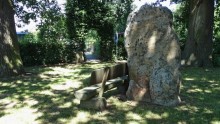|
|
|
|
Wotanstein - MadenStanding Stone / Menhir
|
||||||||||||||||||
|
|
|
Images (click to view fullsize) |
|
Photographs:


 Maps / Plans / Diagrams:
Maps / Plans / Diagrams:
|
Fieldnotes |
|
|
The menhir Wotanstein is situated on the south-west corner of the village of Maden, east of the road K9, which leads from Maden to Obervorschütz. The site is signed, it is less than 50m from the road. The menhir is 2.12m high, 1.2 m wide, and 0.55 m thick, it lies in a small clearing framed by hedges and trees. Why a park bench with its back was set directly on the Menhir remains an eternal mystery to me. I would have placed it at a respectful distance and with a view on the menhir. Visited July 2018 |
12th August 2018ce Edited 12th August 2018ce |
|
taken from the information board: The Wotanstein in Maden The Wotanstein (also "Wodanstein"), is considered one of the most imposing megalithic monuments in Germany. As megaliths (from ancient Greek megas = "large" and lithos = "stone") one refers to large, often uncut stone blocks that were used as building blocks for grave and cultural facilities or erected as monoliths and positioned in stone settings. The Western and Northern European megalithic structures were all built in the Neolithic and Early Bronze Age. The rite of setting up such menhirs (Breton: men = stone, hir = long) was taken over from present-day France. The uniqueness of the Wotanstein is that it consists of non-local quartzite. This material can only be found again in the area of ??Borken, around 25 km away. It is believed that the foundling was brought here and placed in the 3rd millennium BC. An early ritual or religious use is very likely due to the conspicuous accumulation of similar menhirs in the area between Fritzlar and Kassel. The stone was then later (from the 1st millennium before Christ) probably used by the Chatti in the sacral landscape Mattium as a place of worship of Wodan (also "Wotan", main deity in the Nordic-Germanic mythology). The stone was first mentioned in 1407 as "the long stone at Madin". According to oral tradition, the stone has been excavated in the 7-year War (1756-1763) because treasures were suspected under him. But only the remains of human bones were found, and it was realized that it was as deep buried in the earth as it is above the earth. According to legend, the devil wanted to smash the stone from the Lamsberg on the first Christian church of Boniface in Fritzlar, which had been built from the wood of the Donareiche. However, it bounced off the pre-occupied shield of the Archangel Michael and drove to the place where it is today, into the earth. The impressions and holes on the stone were interpreted as handprints of the devil (devil's claw). |
12th August 2018ce Edited 12th August 2018ce |
Links |
|
Wotanstein (Hesse) - Wikipedia |
12th August 2018ce |

